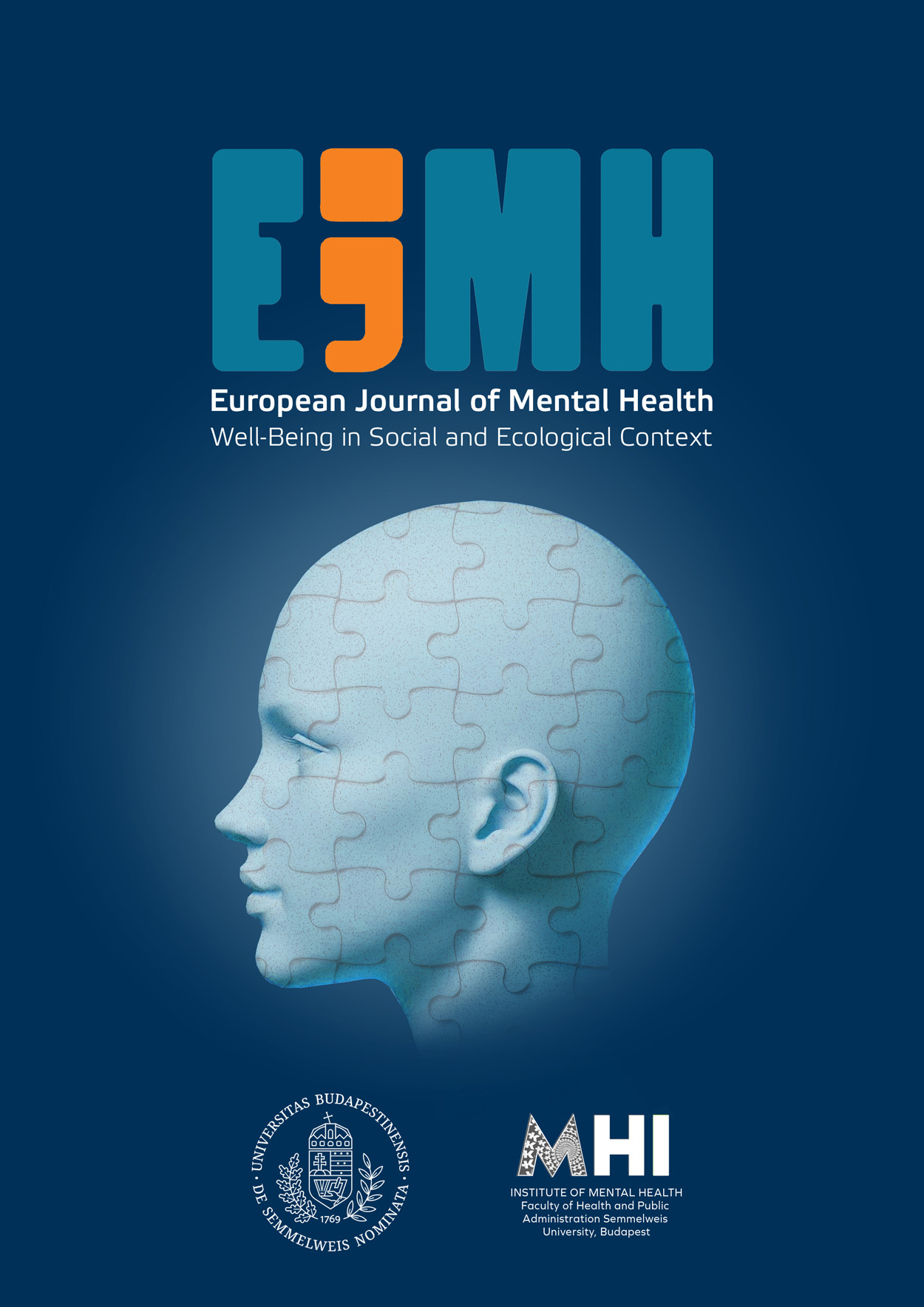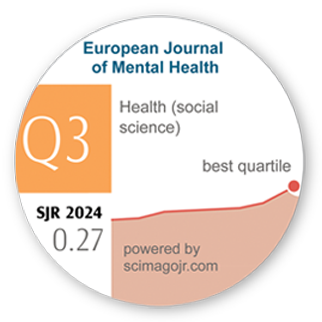Coffee, Energy Drinks Consumption and Caffeine Use Disorder Among Law Enforcement College Students in Hungary
DOI:
https://doi.org/10.5708/EJMH.18.2023.0008Keywords:
caffeine consumption, caffeine use disorder, law enforcement, college students, Caffeine Use Disorder QuestionnaireAbstract
Introduction: Caffeine is one of the most popular and consumed substances worldwide. The prevalence of caffeinated beverage consumption stands quite high among young people and in some professions, such as law enforcement.
Aims: The aim of our study was to assess the lifetime and daily prevalence of caffeine consumption, the extent of consumption, and the prevalence of caffeine use disorder among law enforcement students.
Methods: A cross-sectional, questionnaire-based survey was conducted among Hungarian law enforcement students at the University of Public Service (Hungary) Faculty of Law Enforcement (UPS FLE). The study sample (N = 180) consisted of 57.2% male (n = 103) and 42.8% female (n = 77). The Caffeine Use Disorder Questionnaire (CUDQ) was used to measure caffeine use disorder among law enforcement students.
Results: The lifetime prevalence of caffeine consumption is 98.3% (n = 177) among law enforcement students. Two-fifths (n = 72) of law enforcement students are classified as daily consumers. The average caffeine intake of daily consumers was 177.5 mg/day (range: 60–550 mg/day; SD = 89.54). The majority (64.7%; n = 110) of caffeine users had experienced at least one symptom of caffeine use disorder in the past 12 months.
Conclusions: This is the first study on caffeine consumption among Hungarian law enforcement students. Previous results suggest that the consumption of a high dose of caffeine could compromise aiming accuracy and shot placement, thereby jeopardizing the health and welfare of law enforcement personnel. Our results may be useful for researchers, Hungarian and foreign law enforcement agencies and law enforcement colleges, and vocational schools as well.
References
Abalo, R. (2021). Coffee and Caffeine Consumption for Human Health. Nutrients, 13(9), Article 2918.
https://doi.org/10.3390/nu13092918
Addicott, M. A. (2014). Caffeine Use Disorder: A Review of the Evidence and Future Implications. Current Addiction Reports, 1(3), 186–192.
https://doi.org/10.1007/s40429-014-0024-9
Ágoston, Cs. (2014). A koffeinhasználat motivációs háttere [The motivational background to caffeine use]. In Kővágó P., Vass Z. & Vargha A. (szerk.), II. Országos Alkalmazott Pszichológiai PhD Hallgatói Konferencia [II National Conference of PhD Students in Applied Psychology]. Károli Gáspár Református Egyetem.
Ágoston, Cs. (2018). A koffeinfogyasztás használati jellemzői és pszichológiai vonatkozásai. Doktori disszertáció [Patterns and psychological correlates of caffeine. Doctoral dissertation]. Eötvös Lóránd Tudományegyetem Pszichológiai Doktori Iskola.
Ágoston Cs., Urbán R., & Demetrovics Zs. (2016). A koffeinfogyasztási szokások, koffeinhasználati zavar és kronotípus összefüggései [Relationships between caffeine consumption habits, caffeine use disorder and chronotype]. In Vargha A. (szerk.), Múlt és jelen összeér Past and present meet]. A Magyar Pszichológiai Társaság XXV. Jubileumi Országos Tudományos Nagygyűlése. Kivonatkötet (pp. 244-245). Magyar Pszichológiai Társaság.
Ágoston, C., Urbán, R., Király, O., Griffiths, M. D., Rogers, P. J., & Demetrovics, Z. (2017). Why Do You Drink Caffeine? The Development of the Motives for Caffeine Consumption Questionnaire (MCCQ) and Its Relationship with Gender, Age and the Types of Caffeinated Beverages. International Journal of Mental Health and Addiction, 16(4), 981–999.
https://doi.org/10.1007/s11469-017-9822-3
Ágoston, Cs., Urbán, R., Richman, M. J., & Demetrovics, Zs. (2018). Caffeine use disorder: An item-response theory analysis of proposed DSM-5 criteria. Addictive Behaviors, 81, 109–116.
https://doi.org/10.1016/j.addbeh.2018.02.012
Ágoston, Cs., Urbán, R., Rigó, A., Griffiths, M. D., & Demetrovics, Zs. (2019). Morningness-eveningness and caffeine consumption: A largescale path-analysis study. Chronobiology International, 36(9), 1301–1309.
https://doi.org/10.1080/07420528.2019.1624372
Australian Institute of Sport (2021). Supplements. Benefits and risks of using supplements and sport foods. Retrieved January 17, 2022, from
https://www.ais.gov.au/nutrition/supplements
Amaranto, E., Steinberg, J., Castellano, C., & Mitchell, R. (2003). Police stress interventions. Brief Treatment & Crisis Intervention, 3, 47–53.
http://dx.doi.org/10.1093/brief-treatment/mhg001
An, D. T. M., Hoat, L. N., Son, D. T., Toan, D. T., Minh, L. N., Mai, P. V., & Minh, H. V. (2020). Multilevel Analysis of 24-Hour Blood Pressure, Heart Rate, and Associated Factors among Police Officers in Hanoi, Vietnam. BioMed Research International, 2020, Article 7494906, 1–11.
https://doi.org/10.1155/2020/7494906
Arredondo, G. P. (2019). Incidence of hypertension in a high-risk workgroup (Police officers) – Observational study. Annals of Clinical Hypertension, 3, 052–058.
https://doi.org/10.29328/journal.ach.1001020
Attipoe, S., Leggit, J., & Deuster, P. (2016). Caffeine Content in Popular Energy Drinks and Energy Shots. Military Medicine, 181(9), 1016–1020.
http://dx.doi.org/10.7205/MILMED-D-15-00459
Barone, J. J., & Roberts, H. R. (1996). Caffeine consumption. Food and Chemical Toxicology, 34(1), 119–129.
https://doi.org/10.1016/0278-6915(95)00093-3
Benson, S. M., Unice, K. M., & Glynn, M. E. (2018). Hourly and daily intake patterns among U.S. caffeinated beverage consumers based on the National Health and Nutrition Examination Survey (NHANES, 2013–2016). Food and Chemical Toxicology, 125, 271–278.
https://doi.org/10.1016/j.fct.2018.12.053
Berényi A., Farkas É., Strausz K., & Tóth A. P. (2010). A Debreceni Egyetem hallgatóinak energiaital fogyasztási szokásai. Kutatási jelentés [Energy drink consumption habits of students at the University of Debrecen. Research report]. Debreceni Egyetem Mentálhigiénés és Esélyegyenlőségi Központ.
Bergen-Cico, D., Kilaru, P., Rizzo, R., & Buore, P. (2020). Sterss and well-being of first responders. In. Burke, R. J. & Pignata, S. (Eds.), Handbook of research on stress and well-being in the public sector (pp. 58-73). Edward Elgar Publishing.
Bertasi, R. A. O., Humeda, Y., Bertasi, T. G. O., Zins, Z., Kimsey, J., & Pujalte, G. (2021). Caffeine Intake and Mental Health in College Students. Cureus, 13(4), Article e14313.
https://doi.org/10.7759/cureus.14313
Bors L., Bajza Á., Kocsis D., & Erdő F. (2018). Koffein: hagyományos és új terápiás indikációk, valamint felhasználás dermatológiai modellvegyületként [Caffeine: traditional and new therapeutic indications and use as a dermatological model drug]. Orvosi Hetilap, 159(10), 384–390.
Bouher, B. J. (1989). Demographic study on caffeine consumption. Thesis, Oklahoma State University.
Bovim, G., Næss, P., Helle, J., & Sand, T. (1995). Caffeine influence on the motor steadiness battery in neuropsychological tests. Journal of Clinical and Experimental Neuropsychology, 17(3), 472–476.
https://doi.org/10.1080/01688639508405138
Bradley, H., Healy, G., Forson, C., & Kaul, P. (2007). Workplace cultures: What does and does not work. Equal Opportunities Commission.
Burke, R. J. (1994). Stressful Events, Work-Family Conflict, Coping, Psychological Burnout, and Well-Being among Police Officers. Psychological Reports, 75(2), 787–800.
https://doi.org/10.2466/pr0.1994.75.2.787
Budney, A. J., & Emond, J. A. (2014). Caffeine addiction? Caffeine for youth? Time to act! Addiction, 109(11), 1771–1772.
https://doi.org/10.1111/add.12594
Bunker, M. L., & McWilliams M. (1979). Caffeine content of common beverages. Journal of the American Dietetic Association, 74(1), 28–32.
https://doi.org/10.1016/S0002-8223(21)39775-9
Burg, A. W. (1975). Effects of caffeine on the human system. Tea & Coffee Trade Journal, 147(88), 40–42.
Chin, J. M., Merves, M. L., Goldberger, B. A., Sampson-Cone, A., & Cone, E. J. (2008). Caffeine Content of Brewed Teas. Journal of Analytical Toxicology, 32(8), 702–704.
https://doi.org/10.1093/jat/32.8.702
Conway, T. L., Vickers, R. R., Ward, H. W., & Rahe, R. H. (1981). Occupational Stress and Variation in Cigarette, Coffee, and Alcohol Consumption. Journal of Health and Social Behavior, 22(2), 155–165.
https://doi.org/10.2307/2136291
Copenhaver, R. A. (2016). Exploring differences between the health and wellness of state police officers and community corrections professionals. Electronic Theses and Dissertations. Paper 2429.
https://doi.org/10.18297/etd/2429
Daly, J. W., Shi, D., Nikodijevic, O., & Jacobson, K. A. (1994). The role of adenosine receptors in the central action of caffeine. Pharmacopsychoecologia, 7(2), 201–213.
Dojcsákné Kiss-Tóth É., & Kiss-Tóth E. (2018). Energiaital fogyasztási szokások és egészségtudatosság a felsőfokú képzésben résztvevő hallgatók körében [Energy drink consumption and health awareness among tertiary students]. Egészségfejlesztés, 59(4), 17–26.
http://dx.doi.org/10.24365/ef.v59i4.300
Domokos T., Kántor Z., Pillók P., & Székely L. (2020). A Magyar Fiatalok 2020 [The Hungarian Youth 2020]. Erzsébet Ifjúsági Alap Nonprofit Közhasznú Kft.
European Coffee Federation (2019). European Coffee Report 2018/2019.
https://www.ecf-coffee.org/wp-content/uploads/2020/09/European-Coffee-Report-2018-2019.pdf
EFSA (2015). Scientific Opinion on the Safety of Caffeine. EFSA Journal, 13(5), Article 4102.
https://doi.org/10.2903/j.efsa.2015.4102
El-Nimr, N. A., Bassiouny, S. H., & Tayel, D. I. (2019). Pattern of caffeine consumption among university students. Journal of High Institute of Public Health, 49(3), 154–161.
https://jhiphalexu.journals.ekb.eg/article_56579_98112caa266878aa82a1c45738e224ec.pdf
Fredholm, B. B., Bättig, K., Holmén, J., Nehlig, A., & Zvartau, E. E. (1999). Actions of caffeine in the brain with special reference to factors that contribute to its widespread use. Pharmacological Review, 51(1), 83–133.
Fulgoni, V. L., Keast, D. R., & Lieberman, H. R. (2015). Trends in intake and sources of caffeine in the diets of US adults: 2001–2010. The American Journal of Clinical Nutrition, 101(5), 1081–1087.
https://doi.org/10.3945/ajcn.113.080077
Garrett, B. E., & Griffiths, R. R. (1997). The role of dopamine in the behavioral effects of caffeine in animals and humans. Pharmacology Biochemistry and Behavior, 57(3) 533–541.
https://doi.org/10.1016/S0091-3057(96)00435-2
Gilbert, R. M., Marshman, J. A., Schwieder, M., & Berg, R. (1976). Caffeine content of beverages as consumed. Canadian Medical Association Journal, 114(3), 205–208.
Glaister, M., & Moir, G. (2019). Effects of caffeine on time-trial performance and associated physiological responses: A meta-analysis. Journal of Caffeine and Adenosine Research, 9(2), 40–52.
https://doi.org/10.1089/caff.2019.0003
Greden, J. F. (1974). Anxiety or caffeinism: A diagnostic dilemma. American Journal of Psychiatry, 131(10), 1089–1092.
https://doi.org/10.1176/ajp.131.10.1089
Greenfield, S. F., Back, S. E., Lawson, K., & Brady, K. T. (2010). Substance Abuse in Women. Psychiatric Clinics of North America, 33(2), 339–355.
https://doi.org/10.1016/j.psc.2010.01.004
Greenland, S. (1993). A Meta-analysis of Coffee, Myocardial Infarction, and Coronary Death. Epidemiology, 4(4), 366–374.
https://doi.org/10.1097/00001648-199307000-00013
Grósz A., & Szatmári Á. (2008). Az energiaitalok története és hatása az emberi szervezetre [The history, ingredient and effects of energy drinks]. Orvosi Hetilap, 149(47), 2237–2244.
https://doi.org/10.1556/oh.2008.28491
Grósz A., & Szatmári Á. (2012). Energiaital-fogyasztás repülőorvosi vonatkozásai [Aeromedical aspects of energy drink consumption]. Repüléstudományi Közlemények, 24(2), 674–684.
Hickman, M. J., Fricas, J., Strom, K. J., & Pope, M. W. (2011). Mapping Police Stress. Police Quarterly, 14(3), 227–250.
https://psycnet.apa.org/doi/10.1177/1098611111413991
Statista (2022). Coffee consumption worldwide from 2012/13 to 2020/21 (in million 60kg bags). Retrieved January 15, 2022, from
https://www.statista.com/statistics/292595/global-coffee-consumption/
Jacobson, B. H., Winter-Roberts, K., & Gemmell, H. A. (1991). Influence of caffeine on selected manual manipulation skills. Perceptual and Motor Skills, 72(3_suppl), 1175–1181.
https://doi.org/10.2466/PMS.72.4.1175-1181
Jahrami, H., Al-Mutarid, M., Penson, P. E., Al-Islam Faris, M., Saif, Z., & Hammad, L. (2020). Intake of Caffeine and Its Association with Physical and Mental Health Status among University Students in Bahrain. Foods, 9(4), Article 473.
https://doi.org/10.3390/foods9040473
Katib, A. A., Almalki, H., Surrati, A., & Zeidan, Z.A. (2018). Energy drink consumption among college students in Saudi Arabia. Journal of Food and Nutrition Research, 6(8), 531–536.
http://dx.doi.org/10.12691/jfnr-6-8-8
Kaya, S., Bodur, M., Esgin, M. İ., Çakıroğlu, F. P., & Özçelik, A. Ö. (2021). Validation of the Turkish Version of the Caffeine Use Disorder Questionnaire in an Adult Population. International Journal of Mental Health and Addiction, 2021, 1–12.
https://doi.org/10.1007/s11469-021-00688-8
Kontor E., Szakály Z., Soós M., & Kiss M. (2016). Egészségtudatos magatartás a 14–25 év közötti fiatalok körében [Health-conscious behaviour among young people aged 14–25]. In. Fehér A., Kiss V. Á., Soós M. & Szakály Z. (szerk.), Egyesület a Marketing Oktatásért és Kutatásért (EMOK) XXII. Országos Konferencia. Hitelesség és értékorientáció a marketingben. Tanulmánykötet [Association for Marketing Education and Research (EMOK) XXII National Conference. Credibility and value orientation in marketing]. (pp. 640–649). Debreceni Egyetem Gazdaságtudományi Kar.
KSH (2022). A rendelkezésre álló égetett szeszes italok, kávé, tea, dohány mennyisége (1970–2020) [Quantity of spirits, coffee, tea, tobacco (1970–2020)]. Retrieved June 06, 2022, from
https://www.ksh.hu/stadat_files/mez/hu/mez0060.html.
Köteles, F., Gémes, H., Papp, G., Túróczi, P., Pásztor, A., Freyler, A., Szemerszky, R., & Bárdos, Gy. (2009). A Szomatoszenzoros Amplifikáció Skála (SSAS) magyar változatának validálása [Validation of the Hungarian version of the Somatosensory Amplification Scale (SSAS)]. Mentálhigiéné és Pszichoszomatika, 10(4), 321–335.
https://doi.org/10.1556/mental.10.2009.4.3
Lafata, C. J. (2007). The Effects of Post-Secondary Education on State Troopers’ Job Performance, Stress Levels, and Authoritarian Attitudes. Dissertations, 887. Western Michigan University.
https://scholarworks.wmich.edu/cgi/viewcontent.cgi?article=1889&context=dissertations
Lieberman, H. R., Agarwal, S., & Fulgoni, V. L. (2018). Daily Patterns of Caffeine Intake and the Association of Intake with Multiple Sociodemographic and Lifestyle Factors in US Adults Based on the NHANES 2007–2012 Surveys. Journal of the Academy of Nutrition and Dietetics. 119(1), 106–114.
https://doi.org/10.1016/j.jand.2018.08.152
Mahoney, C. R., Giles, G. E., Marriott, B. P., Judelson, D. A., Gilckman, E. L., Geiselman, P. J., & Liberman, H. R. (2019). Intake of caffeine from all sources and reasons for use by college students. Clinical Nutrition, 38(2), 668–675.
https://doi.org/10.1016/j.clnu.2018.04.004
Malinauskas, B. M., Aeby, V. G., Overton, R. F., Carpenter-Aeby, T., & Barber-Heidal, K. (2007). A survey of energy drink consuption patterns among college students. Nutrition Journal, 6(35), 1–7.
https://doi.org/10.1186/1475-2891-6-35
Mann, J. P. & Neece, J. (1990). Workers' compensation for law enforcement related post traumatic stress disorder. Behavioral Sciences & the Law, 8(4), 447–456.
https://doi.org/10.1002/bsl.2370080410
McLellan, T. M., Caldwell, J. A., & Lieberman, H. R. (2016). A review of caffeine’s effects on cognitive, physical and occupational performance. Neuroscience & Biobehavioral Reviews, 71, 294–312.
https://doi.org/10.1016/j.neubiorev.2016.09.001
McCormick, A. V., Cohen, I. M., & Plecas, D. B. (2011). Nutrition and general duty police work: The case of surrey RCMP officers. BC Centre for Social Responsibility, University of the Fraser Valley, Centre for Public Safety & Criminal Justice Research.
https://www.ufv.ca/media/assets/ccjr/reports-and-publications/Surrey_-_Nutrition_Report.pdf
Meredith, S. E., Juliano, L. M., Hughes, J. R., & Griffiths, R. R. (2013). Caffeine Use Disorder: A Comprehensive Review and Research Agenda. Journal of Caffeine Research, 3(3), 114–130.
https://doi.org/10.1089/jcr.2013.0016
Meeusen, R., Roelands, B., & Spriet, L. L. (2013). Caffeine, exercise and the brain. In. van Loon, L. J. C., & Meeusen, R. (Eds.), Limits of Human Endurance. Nestlé Nutrition Institute Workshop Series, Volume 76. S. Karger AG.
https://doi.org/10.1159/000350223
Miller, K. E. (2008). Energy drinks, race, and problem behaviors among college students. Journal of Adolescent Health, 43(5), 490–497.
https://doi.org/10.1016/j.jadohealth.2008.03.003
Mineharu, Y., Koizumi, A., Wada, Y., Iso, H., Watanabe, Y., Date, C., Yamamoto, A., Kikuchi S., Inaba, Y., Toyoshima, H., Kondo, T., Tamakoshi, A., & JACC study Group (2009). Coffee, green tea, black tea and oolong tea consumption and risk of mortality from cardiovascular disease in Japanese men and women. Journal of Epidemiology & Community Health, 65(3), 230–240.
https://doi.org/10.1136/jech.2009.097311
Monaghan, T. P., Jacobsen, B. H., & Sellers, J. H. (2014). Effects of a commercial energy shot on pistol steadiness in law enforcement officers. International Journal of Exercise Science: Conference Proceedings, 11(2), Article 38.
https://digitalcommons.wku.edu/ijesab/vol11/iss2/38
Monaghan, T. P., Jacobson, B. H., Sellers, J. H., & Estrada, C. A. (2017). Effects of Energy Beverage Consumption on Pistol Aiming Steadiness in Law Enforcement Officers. Journal of Strength and Conditioning Research, 31(9), 2557–2561.
https://doi.org/10.1519/jsc.0000000000002015
Nagy, M. & Litt, J. Z. (1974). Caffeine content of beverages and chocolate. Journal of the American Medical Association, 229(3), Article 337.
Năsui, B. A., Ungur, R. A., Talaba, P., Varlas, V. N., Ciuciuc, N., Silaghi, C. A., Silaghi, H., Opre, D., & Pop, A. L. (2021). Is Alcohol Consumption Related to Lifestyle Factors in Romanian University Students? International Journal of Environmental Research and Public Health, 18(4), Article 1835.
https://doi.org/10.3390/ijerph18041835
Nawrot, P., Jordan, S., Eastwood, J., Rotstein, J., Hugenholtz, A., & Feeley, M. (2003). Effects of caffeine on human health. Food Additives and Contaminants, 20(1), 1–30.
https://doi.org/10.1080/0265203021000007840
O'Brien, M. C., McCoy, T. P., Rhodes, S. D., Wagoner, A., & Wolfson, M. (2008). Caffeinated cocktails: Energy drink consumption, high-risk drinking, and alcohol-related consequences among college students. Academic Emergency Medicine, 15(5), 453–460.
https://doi.org/10.1111/j.1553-2712.2008.00085.x
Ogeil, R. P., Barger, L. K., Lockley, S. W., O'Brien, C. S., Sullivan, J. P., Qadri, S., Lubman, D. I., Czeisler, C. A., & Rajaratnam, S. M. W. (2018). Cross-sectional analysis of sleep-promoting and wake-promoting drug use on health, fatigue-related error, and near-crashes in police officers. BMJ Open, 8(9), Article e022041.
https://doi.org/10.1136/bmjopen-2018-022041
Olekalns, N. & Bardsley, P. (1996). Rational Addiction to Caffeine: An Analysis of Coffee Consumption. Journal of Political Economy, 104(5), 1100–1104.
https://doi.org/10.1086/262054
Olsen, J. (1991). Cigarette smoking, tea and coffee drinking, and subfecundity. American Journal of Epidemiology, 133(7), 734–739.
https://doi.org/10.1093/oxfordjournals.aje.a115948
Palatini, P., Fania, C., Mos, L., Garavelli, G., Mazzer, A., Cozzio, S., Saladini, F., & Casiglia, E. (2016). Coffee consumption and risk of cardiovascular events in hypertensive patients. Results from the HARVEST. International Journal of Cardiology, 212, 131–137.
https://doi.org/10.1016/j.ijcard.2016.03.006
Rehm, C. D., Ratliff, J. C., Riedt, C. S., & Drewnowski, A. (2020). Coffee Consumption among Adults in the United States by Demographic Variables and Purchase Location: Analyses of NHANES 2011–2016 Data. Nutrients, 12(8), Article 2463.
https://doi.org/10.3390/nu12082463
Reissig, C. J., Strain, E. C., & Griffiths, R. R. (2009). Caffeinated energy drinks – A growing problem. Drug and Alcohol Dependence, 99(1–3), 1–10.
https://doi.org/10.1016/j.drugalcdep.2008.08.001
Ribeiro, J. A. & Sebastião, A. M. (2010). Caffeine and adenosine. Journal of Alzheimer’s Disease, 20(S1), S3–S15.
https://doi.org/10.3233/jad-2010-1379
Rodrigues, C. F., Raposo, H., Pegado, E., & Fernandes, A. I. (2021). Coffee in the Workplace: A Social Break or a Performance Enhancer? Medical Sciences Forum, 5(1), Article 44.
https://doi.org/10.3390/msf2021005044
Rogers, P. & Wesnes, K. (2017). The good things in life: coffee in the workplace. Expert report. Institute for Scientific Information on Coffee.
https://assets-global.website-files.com/61278f4a0fe77893a00f1f11/613ded926c60bf102038942f_Coffee-in-the-Workplace-report-FINAL-250917.pdf
Roehrs, T., & Roth, T. (2008). Caffeine: Sleep and daytime sleepiness. Sleep Medicine Reviews, 12(2), 153–162.
https://doi.org/10.1016/j.smrv.2007.07.004
Sertbas, Y. (2014). Prevalence and clinical characteristics of irritable bowel syndrome (IBS) in police officers in Istanbul. Scientific Research and Essays, 9(12), 535–539.
https://doi.org/10.5897/SRE2013.5763
Souissi, M., Abedelmalek, S., Chtourou, H., Atheymen, R., Hakim, A., & Sahnoun, Z. (2012). Effects of morning caffeine' ingestion on mood States, simple reaction time, and short-term maximal performance on elite judoists. Asian Journal of Sports Medicine, 3(3), 161–168.
https://doi.org/10.5812/asjsm.34607
Swanson, J. A., Lee, J. W., & Hopp, J. W. (1994). Caffeine and nicotine: A review of their joint use and possible interaction effects in tobacco withdrawal. Addictive Behaviors, 19(3), 229–256.
https://doi.org/10.1016/0306-4603(94)90027-2
Sweeney, M. M., Weaver, D. C., Vincent, K. B., Arria, A. M., & Griffiths, R. R. (2019). Prevalence and Correlates of Caffeine Use Disorder Symptoms Among a United States Sample. Journal of Caffeine and Adenosine Research, 10(1), 1–8.
https://doi.org/10.1016/0306-4603(94)90027-2
Torpy, J. M. & Livingston, E. H. (2013). Energy Drinks. Journal of the American Medical Association, 309(3), Article 297.
https://doi.org/10.1001/jama.2012.170614
Tsiga E., Panagopoulou E., & Niakas D. (2015). Health promotion across occupational groups: one size does not fit all. Occupational Medicine (Oxford, England), 65(7), 552–557.
https://doi.org/10.1093/occmed/kqv097
Tucker, K. L. (2003). Dietary intake and bone status with aging. Current Pharmaceutical Design, 9(32), 2687–2704.
https://doi.org/10.2174/1381612033453613
Willson, C. (2018). The clinical toxicology of caffeine: A review and case study. Toxicology Reports, 5, 1140–1152.
https://doi.org/10.1016/j.toxrep.2018.11.002






